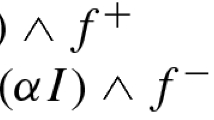Abstract
The so-called basic algebras correspond in a natural way to lattices with antitone involutions and hence generalize both MV-algebras and orthomodular lattices. The paper deals with several types of special elements of basic algebras and with pseudocomplemented basic algebras.
Similar content being viewed by others
Notes
A note on terminology: when speaking of lattices with antitone involution(s), we omit the adjective “bounded”.
In the variety generated by linearly ordered basic algebras, (2.13) is equivalent to the quasi-identity \(x\le y\) \(\Rightarrow \) \(z\oplus x\le z\oplus y\), but we do not know whether this is true in general.
Given \(B\subseteq A\), this is not equivalent to saying that \((B,\vee ,\wedge ,\lnot ,0,1)\) is a Boolean algebra. It can easily happen that \((B,\vee ,\wedge ,\lnot ,0,1)\) is a Boolean algebra, but \((B,\oplus ,\lnot ,0,1)\) is not a Boolean subalgebra of \((A,\oplus ,\lnot ,0,1)\), because B need not be closed under \(\oplus \).
As in the case of Boolean subalgebras, this is stronger than saying that \((B,\vee ,\wedge ,\lnot ,0,1)\) is an orthomodular lattice.
This means that the relative complementation in [a, 1], which is the natural antitone involution in [a, 1], is replaced with another antitone involution. Of course, this is possible, provided that the interval has more than two elements. For a concrete example, see Chajda and Kühr (2013b), Example 3.1 or Krňávek and Kühr (2015), Example 14.
References
Balbes R, Dwinger P (1975) Distributive lattices. University of Missouri Press, Columbia
Botur M, Halaš R (2008) Finite commutative basic algebras are MV-effect algebras. J Mult Valued Log Soft Comput 14:69–80
Botur M, Kühr J (2014) On (finite) distributive lattices with antitone involutions. Soft Comput 18:1033–1040
Botur M, Kühr J, Rachůnek J (2014) On states and state operators on certain basic algebras. Int J Theor Phys 53:3512–3530
Chajda I, Emanovský P (2004) Bounded lattices with antitone involutions and properties of MV-algebras. Discuss Math Gen Algebra Appl 24:31–42
Chajda I, Halaš R, Kühr J (2009a) Many-valued quantum algebras. Algebra Univ 60:63–90
Chajda I, Halaš R, Kühr J (2009b) Every effect algebra can be made into a total algebra. Algebra Univ 61:139–150
Chajda I, Kolařík M (2009) Direct decompositions of basic algebras and their idempotent modifications. Acta Univ M Belii Ser Math 25:11–19
Chajda I, Kühr J (2013) Finitely generated varieties of distributive effect algebras. Algebra Univ 69:213–229
Chajda I, Kühr J (2013) Ideals and congruences of basic algebras. Soft Comput 17:401–410
Cignoli RLO, D’Ottaviano IML, Mundici D (2000) Algebraic foundations of many-valued reasoning. Kluwer, Dordrecht
Dvurečenskij A, Pulmannová S (2000) New trends in quantum structures. Kluwer and Ister Science, Dordrecht and Bratislava
Foulis D, Bennett MK (1994) Effect algebras and unsharp quantum logics. Found Phys 24:1331–1352
Grätzer G (2011) Lattice theory: Foundation. Birkhäuser, Basel
Jenča G, Riečanová Z (1999) On sharp elements in lattice-ordered effect algebras. BUSEFAL 80:24–29
Kalman JA (1958) Lattices with involution. Trans Am Math Soc 87:485–491
Kalmbach G (1983) Orthomodular lattices. Academic Press, London
Kôpka F, Chovanec F (1994) D-posets. Math Slov 44:21–34
Krňávek J, Kühr J (2011) Pre-ideals of basic algebras. Int J Theor Phys 50:3828–3843
Krňávek J, Kühr J (2015) A note on derivations on basic algebras. Soft Comput 19:1765–1771
Krňávek J, Kühr J (2016) On non-associative generalizations of MV-algebras and lattice-ordered commutative loops. Fuzzy Sets Syst 289:122–136
Kühr J, Chajda I, Halaš R (2015) The join of the variety of MV-algebras and the variety of orthomodular lattices. Int J Theor Phys 54:4423–4429
Riečanová Z (1997) Compatibility and central elements in effect algebras. Tatra Mt Math Publ 10:119–128
Riečanová Z (1999) Subalgebras, intervals and central elements of generalised effect algebras. Int J Theor Phys 38:3209–3220
Riečanová Z (2009) Pseudocomplemented lattice effect algebras and existence of states. Inf Sci 179:529–534
Acknowledgements
The authors would like to thank the anonymous reviewer for his/her comments.
Funding
P. E. was supported by the Palacký University project “Mathematical structures”, No. IGA PrF 2016 006. J. K. was supported by the project “Algebraic, many-valued and quantum structures for uncertainty modelling” of the Czech Science Foundation (GAČR), No. 15-15286S.
Author information
Authors and Affiliations
Corresponding author
Ethics declarations
Conflict of interest
The authors declare that they have no conflict of interest.
Ethical approval
This article does not contain any studies with human participants or animals performed by any of the authors.
Additional information
Communicated by A. Di Nola.
Rights and permissions
About this article
Cite this article
Emanovský, P., Kühr, J. On special elements and pseudocomplementation in lattices with antitone involutions. Soft Comput 22, 4561–4572 (2018). https://doi.org/10.1007/s00500-017-2926-7
Published:
Issue Date:
DOI: https://doi.org/10.1007/s00500-017-2926-7



